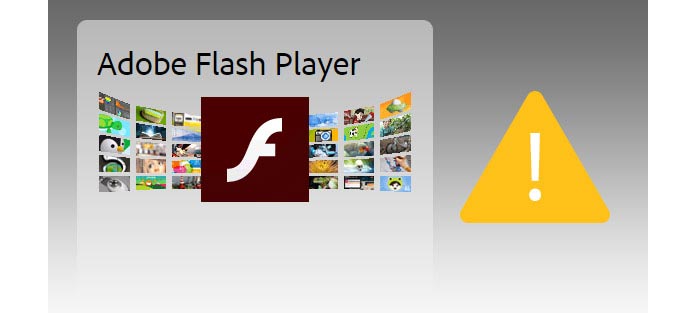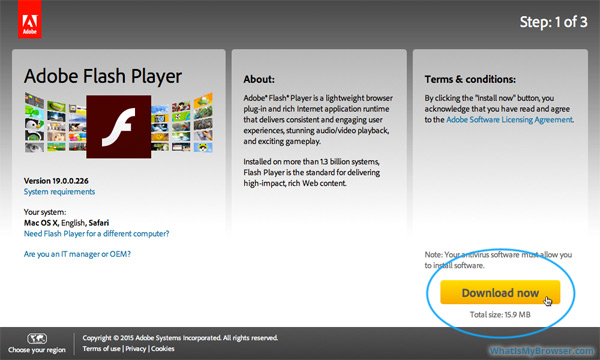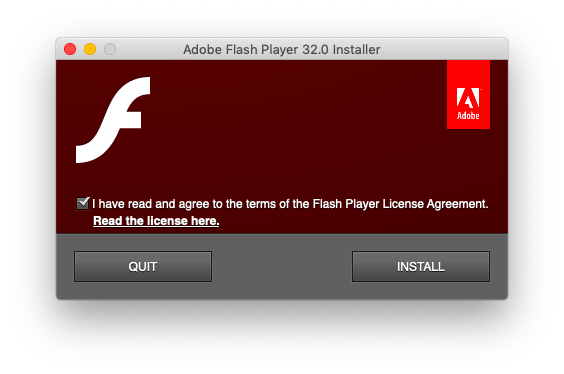Mac Os X Install Adobe Flash Player
Adobe Flash Player is a multimedia player that plays the SWF and is in-built in most browsers. Flash Player for Mac is compatible with Firefox, Chrome, and Opera. While the program takes low network bandwidth and the websites with flash animations load faster on Mac devices, the program takes up a lot of CPU resources. Download Adobe Flash Player for Mac now from Softonic: 100% safe and virus free. More than 51358 downloads this month. Download Adobe Flash Player latest version 2021. There are three general versions available, covering Mac OS X 10.1 to 10.3, OS X 10.4 and 10.5, and OS X 10.6 and later including macOS, so make sure to download the appropriate version for your. Locate Adobe Flash Player Install Manager on your Mac 1. From the Menu bar at the top of the screen, click on Go and select Utilities. If you can’t find Utilities, it also appears in the Application folder.
Got a message that says you have to update Flash Player on Mac? Don’t promptly click the update button. If you are not careful, you can accidentally install adware or malware instead of Flash Player. And that’s not what you need, right?
In this article we’ll show you the best way to check for Flash updates and also give you a comprehensive guide to update Adobe Flash Player for Mac safely. Plus, we’ll tell you how to uninstall it from your computer completely.

What is Flash Player?
For years, Adobe Flash Player has been one of the most popular plug-ins used by web browsers to reproduce videos, web ads, and interactive animations. But now its position is rocked by some security concerns and safer alternative solutions.
Google Chrome and Firefox contain the built-in version of Flash running in the sandboxed mode. This method is safer than running Flash as a plugin. What about Safari, it disables Flash Player by default starting from macOS Sierra. The point is that Apple wants you running on HTML5 — the newer and safer way of browsing the web. It supports the same multimedia elements as Flash but without any security issues.
However, the reality is that you still may need the Adobe Flash Player on your Mac. Many websites will not work if you uninstall it completely. Live streams like BT Sport can only be delivered in Flash, so if you are the BT Sport customer, you’ll want to keep the Flash Player. In addition, a great number of gaming and education sites use Flash and until they implement the HTML5 standards, you’ll need the Flash Player.
Flash Player For Mac Os
Why watch out for Flash updates on Mac?
Install Adobe Flash Player For Mac Os X 10.6.8
Adobe is always trying to push its technology further and release the Flash updates to enhance the user experience and security. However, attackers still find the ways to trick you into downloading adware and malware through the popups. That’s why you should know how to protect your Mac against the malicious attacks when you’re trying to update your Adobe Flash for Mac.
Fortunately, it’s easy to make sure that you are installing the real Flash for Mac and are not exposed to the vulnerable software. All you have to do is to be careful and don’t trust the automatic updates.
How to update Flash Player on Mac (if it’s already installed)
Instead of downloading anything from a popup, follow simple steps to check whether you really need to update Adobe Flash on Mac.
Go to the Apple menu and click System Preferences.
In the bottom left corner, choose Flash Player.
Choose the Updates tab.
Click the Check Now button.
If an update is available, click Yes to update. If no updates are available, you have the latest version of a Flash Player for Mac installed.
Easy enough, right? Make sure to invest some time and check if you do need to update Flash. Otherwise, downloading a false software package may harm your computer.

How to install Flash on your Mac safely
Adobe Flash On Mac
If Flash is not installed, which is by default on all new Macs, here’s a step-by-step guide to install it safely.
Visit the Adobe Flash Player page.
Click the Download now button.
The installer will download to your computer. If you’re using Safari, the file will go to your Downloads folder. If you’re using another browser, it may ask where to save the file.
Open your Downloads folder and find the .dmg installer file.
Double-click the Install Adobe Flash Player file.
You will be asked if you really want to install Adobe Flash Player. Read the message carefully to make sure that it’s the file you just downloaded. Click Open to proceed.
Agree to terms and conditions by clicking a checkbox.
Click the Install button.
In the window that appears, type your username and password.
Click the Install Helper button.
Click Allow Adobe to install updates (recommended).
Click Done.
That’s it. It’s also recommended to relaunch your web browser after installing Flash.
How to uninstall Flash completely
If you’re concerned about the security flaws associated with your Adobe Flash Player, we’ll show you how to uninstall it from your Mac.
Usually, uninstalling Flash can cause a bit of headache. But with CleanMyMac X, you can remove Adobe Flash Player in a few clicks. Just follow these simple steps:
Download CleanMyMac X and launch it.
Go to the Extensions in the sidebar.
Click Preferences Panes and then checkmark Flash Player.
Click the Remove button.
As you see, uninstalling Flash with CleanMyMac X is as easy as pie. Moreover, the whole process won’t take more than five minutes. Try it out to uninstall Flash Player on Mac completely.
That’s it! Follow the tips above and don’t let the tricky popups and websites take advantage of you. This way you’ll stay up-to-date safely.
Install Adobe Flash Player Mac Os X
It's 2021, and Adobe is no longer supporting the Flash Player, so it's about time you uninstalled it from your Mac. Here's how to get rid of the relic from an older Internet browsing era.
Flash was a major element of early web browsing, used to power various animations, forms, and other interactive elements on a website for a user. It was embraced as it offered more options to web developers and media creators than HTML, animated GIFs, and other basic technologies of the time.
However, as browsers improved, and started to sue open standards like HTML5, WebGL, and WebAssembly among others, Flash fell by the wayside as the dominant way to provide interactivity. The increased use of the Flash player installer for malware purposes also probably hastened its demise.
Adobe announced in 2017 it would cease development and distribution of Flash Player by the end of 2020, and encourage the adoption of other open formats for content that uses Flash. At the time, Adobe cited a collaboration with Apple, Facebook, Google, Microsoft, and Mozilla as being the impetus behind the decision to end-of-life the technology.
Since that announcement, Adobe continued to support Flash with security patches and other updates, setting its actual EOL date to be December 31, 2020. From January 1, 2021, Adobe would cease supporting Flash Player itself, followed by setting the software to block Flash content from running at all from January 12.
To end users, this will largely mean Adobe doesn't intend to issue Flash Player updates or security patches anymore. Since Flash can potentially be a security risk, especially with no further updates on the horizon, Adobe is actively advising users to uninstall the Flash Player from their computers.
Adobe has even taken the step of removing download pages for Flash Player from its website, to prevent anyone curious from being tempted to install it for themselves in its last days of life.
Major browser vendors are also disabling Flash Player from running from the EOL date. For Mac browsers, Safari disabled support for Adobe Flash in early 2020, after previously requiring users to explicitly enable it, while Firefox version 84.0 is the last with support for Flash, and the same removal of support is on the way for Chrome and Microsoft Edge.
For iPhone and iPad users, Flash hasn't ever been a problem, as iOS and iPadOS devices never supported the technology.
Flash isn't being completely killed off, however, as Adobe has offered support avenues for enterprise customers needing Flash Player for internal business systems. For the web at large, however, Flash is basically dead.
While web browsers are removing support and it will be seemingly inert, there's still some work you have to do to get rid of the last remnants of it from your Mac. The Flash Player is a separate application that needs to be uninstalled, before you can seriously consider your Mac Flash-free.
First, you have to download the appropriate uninstaller for your version of macOS or Mac OS X. There are three general versions available, covering Mac OS X 10.1 to 10.3, OS X 10.4 and 10.5, and OS X 10.6 and later including macOS, so make sure to download the appropriate version for your Mac's operating system.
Adobe Flash Player Mac Os X Yosemite
How to uninstall Flash Player for Mac OS X 10.4 or later and macOS
- Open the uninstaller.
- Click Uninstall.
- Close all browsers if any are open, either manually or by clicking each browser name in the uninstaller dialog box. Click Retry if necessary.
- Wait for the uninstaller to complete. Click Done.
- Open Finder, then locate and delete the directory /Library/Preferences/Macromedia/FlashPlayer
- Staying in Finder, locate and delete the directory /Library/Caches/Adobe/FlashPlayer
- Open a browser at this link to verify it has uninstalled.
How to uninstall Flash Player for Mac OS X 10.1 to 10.3
- Open the uninstaller.
- If needed, authenticate with your Mac.
- Click Continue.
- Once it has completed, the uninstaller will close automatically.
- Open a browser at this link to verify it has uninstalled.


AppleInsider has affiliate partnerships and may earn commission on products purchased through affiliate links. These partnerships do not influence our editorial content.
